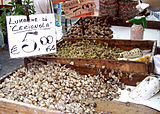Paphies ventricosa
| Paphies ventricosa | |
|---|---|
| Scientific classification | |
| Kingdom: | |
| Phylum: | |
| Class: | |
| Order: | |
| Superfamily: | |
| Family: | |
| Genus: | |
| Species: | P. ventricosa
|
| Binomial name | |
| Paphies ventricosa (Gmelin, 1790)
| |
Paphies ventricosa, or toheroa, (which means "long tongue" in the Māori language),[1] is a large bivalve mollusc of the family Mesodesmatidae, endemic to New Zealand. It is found in both the North and South Islands, but the main habitat is the west coast of the North Island. The best grounds are wide fine-sand beaches where there are extensive sand-dunes, enclosing freshwater, which percolates to the sea, there promoting the growth of diatoms and plankton generally.
The toheroa is a very large shellfish with a solid white, elongated shell with the apex at the middle. The toheroa has been an extremely popular seafood, often made into a greenish soup,[2] for which it has an international reputation. However it was over-exploited in the 1950s and 1960s, and a total and ongoing ban on harvesting is now in place.
Maximum length is 117 mm, height 81 mm, and thickness 38 mm.
References
- ^ Edward Samuel. "The Toheroa — New Zealand's Exclusive Shell-fish". The New Zealand Railways Magazine, Volume 11, Issue 4 (July 1, 1936).
- ^ "Toheroa Soup" (PDF).
- Checklist of New Zealand Mollusca
- Powell A. W. B., New Zealand Mollusca, William Collins Publishers Ltd, Auckland, New Zealand 1979 ISBN 0-00-216906-1


